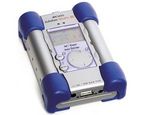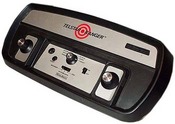About six years ago I bought a surround sound system. At the time Dolby Digital 5.1, where a DVD would have six distinct tracks of audio, was still pretty rare (they had Dolby Surround aka Dolby 2.0) and there was a premium for receivers that could decode the signal. Instead I found a DVD player that would decode it and had outputs for all six signals. The AIWA audio system I chose also lacked a separate subwoofer (the ".1" part of "5.1") so I never had the thundering bass of some systems. Most annoyingly, the surround speakers would emit a low static noise whenever the receiver was on, which became annoying if there wasn't any other sound to drown it out. I had other nits to pick as well, like any time the power went out, the thing would flash the time. I don't know why the receiver needed to know the time in the first place.
So I had been looking for a replacement. When a friend at work was shopping for them several months ago I almost bought a system that consisted of a combined DVD and amplifier which would simplify the tangle of connections behind the coffee table with my video equipment. Ultimately I decided against that option because I didn't want to be stuck with an old-fashioned DVD player in the system, knowing I would get a HD-DVD or Blu-ray player in the next couple of years (once the formats stop competing and the prices come down).
But for some reason I got the bug again and started researching my options. Eventually I found a system ranked highly by Consumer Reports made by Onkyo (model HT-S790). It was about the same price as the AIWA system was all of those years ago, but included a powered subwoofer, Dolby 5.1 and DTS (a different 5.1 system) decoding. And it had 7 surround speakers instead of 5. It was also a good fit for me because it allowed 3 optical audio inputs and I had three devices with optical out. Instead of using wires, there is a fiber optic line that carries a red laser signal between the component (DVD player, satellite receiver, or HD receiver in my case) and the receiver. That way there is no electronic interference and the digital signal loses no information. And that one cable carries all of the audio that might otherwise be carried by six different copper cables. So I also bought three of these cable off of Amazon for about $5 each (actually they were $.01 with $5 shipping each; but they work at least). The optical system is called Toslink where "tos" is short for Toshiba, who developed it.
Circuit City seems to be a major seller of the Onkyo system and their website had tons of glowing reviews whereas other systems I was looking at by Sony and Panasonic had a number of people who were not happy. They were running a special with $100 off and offered a $50 rebate on the silver model (it is also available in black). I visited a Circuit City this weekend to look at the system, but they didn't offer any of the markdowns so they were still selling the system at $500. I ordered it online Sunday and got free shipping. For an extra $5 I got third day shipping and the 97-pound box arrived Wednesday, from Marion, Illinois, in time for the 2007 premier of Lost.
Eventually I found a very good thread about this particular system, which again reinforced what a good value the system is (you can get better systems by buying separate components, but they will cost at least twice as much). They also had a good tip on some speaker stands from Walmart which I bought on Tuesday.
I spent a couple of hours Wednesday night setting the system up. I don't have the back speakers hooked up yet, but I don't have any sources that use those speakers directly anyway (you can run a mode where some of the surround sound will be directed to the back speakers). High def DVD's support 7.1 sound.
I was a little disappointed that Dish Network offers hardly any shows with 5.1 audio. They have a couple of pay-per-view movies that have it, but that's it. So mostly you just get stereo. The HD broadcast of Lost did use 5.1 sound, but I didn't notice it much. Plus, because I'm receiving HD channels over a rooftop antenna, only about half of the stations are consistently clear (Lost's network, ABC, sometimes drops out but was pretty clear last night; Sunday's Superbowl on CBS was unwatchable on HD for me). Tonight I tried a DVD with DTS audio, Master and Commander. I tuned to one of the battles where ships are firing cannons at each other. It was impressive, with deep booming from the subwoofer, and splintering planks and explosions in the surround speakers.
One problem with how I have the system right now is that I have to switch the audio separately from the video. So if I want to switch from satellite to HD I have to switch the TV for the video and then switch the receiver for the audio. If I just use the TV speakers that isn't a problem. Onkyo lets you connect all of your video sources (up to five I think) to the receiver and then you switch between them via the receiver. But that means you always have to use the receiver for audio. I don't know that I want to do that yet.
 Well, kind of. If I hooked it up to my computer (had to install the drivers since my current computer had never seen the Archos before) it would act as an external hard drive, but by itself it wouldn't spin up its hard drive and seemed to freeze while trying to boot up. I could turn it off and it would flash HD FAIL before turning off. So it was useless as a music player.
Well, kind of. If I hooked it up to my computer (had to install the drivers since my current computer had never seen the Archos before) it would act as an external hard drive, but by itself it wouldn't spin up its hard drive and seemed to freeze while trying to boot up. I could turn it off and it would flash HD FAIL before turning off. So it was useless as a music player.
